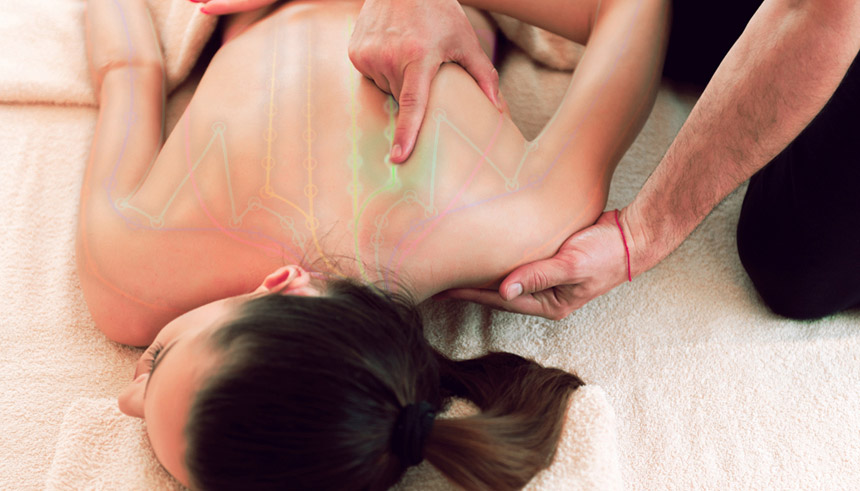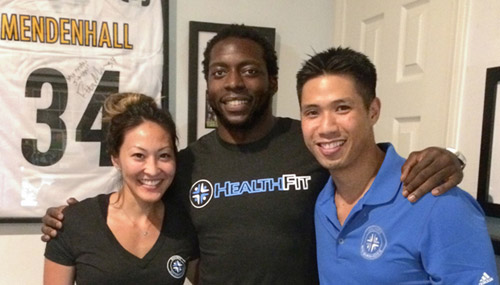East West Lifestyle
Integrating Eastern and Western Medical Therapies
By John Ji

Doctors are using Eastern medicine and therapies to complement Western treatments.
When former Pittsburgh Steelers running back Rashard Mendenhall was suffering from hamstring injuries in the 2009-10 NFL season, he turned to Physical Therapist Jason Han, who incorporated Eastern medical practices into the treatment. “Jason flushed out any swelling, broke up the scar tissue, and worked the parts of my body around the injury, causing it to function properly and not just feel better,” Mendenhall says. He went on to run 1,273 yards and to make 13 touchdowns in the following season, eventually bringing the Steelers to the Super Bowl XLV stage.
Eastern medical therapies have been around for millennia and continue to gain popularity worldwide. In the United States, approximately 33 percent of adults and 12 percent of children use complementary and alternative medicine, which are health-care approaches developed outside of conventional Western medicine. These approaches predominantly consist of Eastern methods such as acupuncture, manipulation, tai chi, herbal treatment, gua sha (skin scraping), etc. According to the most recent cost data from National Health Interview Survey, Americans spent $33.9 billion in out-of-pocket costs on complementary and alternative medicine.
In response to the growing demand, the number of hospitals across the country offering Eastern-based therapies as a supplement to conventional medical care has tripled since 2000.
Jason Han has established a multidisciplinary wellness center called Healthfit Inc. in Pasadena, Calif., with his wife, Kelli, practicing physical and chiropractic therapy using Eastern philosophy and methodology. “In Eastern medicine, everything is connected, which provides us with a much more holistic view of wellness,” Jason Han says.
On the other side of town, Dr. Ka-Kit Hui heads up the University of California at Los Angeles’ Center for East-West Medicine. Founded in 1993, the center blends Western and traditional Chinese medicine in its patient care. “We have three clinics in the western part of Los Angeles that run daily,” Hui says.
Viewing the person as a dynamic whole
“Growing up, I only went to Chinese herbalists or acupuncturists,” says Jason Han, a doctor of physical therapy. “It was mostly my dad’s decision, but I got to learn the philosophy of Eastern medicine, which views the person as a dynamic whole.” A former Olympic-level Taekwondo athlete, he has helped more than 100 top athletes like Mendenhall with rehabilitations and performance enhancement, including Boston Red Sox pitcher Joe Kelly, four-time volleyball Olympian Logan Tom and Phoenix Suns forward Chase Budinger.
Most conventional physical therapists follow a standard protocol for treating certain conditions. “In that sense, it’s very mechanical and orthopedic,” Jason Han says, “but the reason someone can’t move in a certain way isn’t just orthopedic all the time.” In contrast, Jason Han focuses on how an individual moves and interacts with the environment, and how to change their unhealthy movements and habits.
“If a person comes in for knee pain, I don’t just look at the knee; I look at the ankle, the hip, the core, and the way they walk,” Jason Han says, “and that’s the same idea as in Eastern medicine – we are looking at the whole person, getting to know their life patterns and stress levels.” His whole-person approach is inspired by his early exposure to traditional Chinese medicine, which uses four diagnostic methods – “inspection (wang), listening and smelling (wen), inquiring (wen) and palpation (qie).” For thousands of years, Chinese medicine practitioners have relied on these principles to get a holistic assessment of their patients.
“I listen to their stories and ask about their goals,” Jason Han says. Based on a holistic understanding of the patient, he watches the patient’s movements closely, and then evaluates if bad posture is caused by a limited range of motion, or a lack of functional strength, stability or coordination. He designs drills that mimic different phases of a certain athletic movement to improve mobility and functional athleticism. “Beyond that, I do a lot of Eastern manual therapy, such as cupping and gua sha, to enhance the flow of qi [the vital energy in Chinese medicine], which accelerates recovery and relaxes the muscles.” Jason Han also points out that emotions play an important role. “In many cases, the patient’s frustration over injury impedes recovery, so we need to know the bigger picture and help build a positive mentality through counseling and progressive training.”

"When there is an injury, he doesn’t just treat the problem, but every part of the body."
“Jason has a total understanding of how the entire body works,” Mendenhall says. “When there is an injury, he doesn’t just treat the problem, but every part of the body.” By analyzing Mendenhall’s movements and which ones caused his pain, Jason Han precisely pinpointed what Mendenhall needed most. Han used a combination of Chinese manual therapies and therapeutic exercises to restore Mendenhall to top form.
Healing the body from the inside out
Kelli Han, a Doctor of Chiropractic, uses applied kinesiology – an evaluation and treatment system based on the belief that various muscles are connected to certain organs. She starts by testing the strength and function of a patient’s muscles. If muscle weakness is discovered during muscle testing, “I can determine which organs are not functioning well and where the weak links in the body exist,” she says. ‘’Then I go deeper and figure out if there is a nutritional cause, emotional cause or structural cause.” Her therapies include muscle release, spinal adjustment, herbal supplement and emotional therapeutic work. In addition, Kelli Han uses Chinese meridian therapy. “Meridians are the energy channels qi flows through and they are connected to different organs,” she says. By massaging the meridians, she stimulates the flow of qi and restores the body’s inner balance.
"We want to dig into the root cause of the condition and give the body what it needs to heal from the inside out."

The core philosophy of the Eastern whole-person approach is that mind and body are interconnected. During the past two decades, evidence has emerged proving that psychological factors can play a major role in the treatment of illnesses, and clinical trials have indicated mind-body therapies’ efficacy in managing chronic pain conditions. Congress has appropriated more than $1,204 million in each of the past 10 years to the National Center for Complementary and Integrative Health to focus on researching these approaches.
“With the Western approach, doctors tend to mask outside symptoms with medication,” says Kelli Han. When asked to compare her methodology with Western medicine, she says Western medicine “is like a Band-Aid, which will fall off anyway, whereas we want to dig into the root cause of the condition and give the body what it needs to heal from the inside out.”
A new health-care paradigm
U.S. health-care expenditures grew 5.3 percent to reach $3 trillion in 2014, accounting for 17.5 percent of the nation’s GDP. According to the World Bank’s latest data, the United States spent more money on health care per capita (in constant 2011 international dollars) than any other nation in the world.
“But still, a lot of people are not getting sufficient health care, and health care is causing close to 50 percent of personal bankrupcies in the U.S.,” says UCLA’s Hui. In his opinion, it’s a major crisis caused by unsustainability: the increasing rate of chronic illnesses shows the current health-care system’s preventative care is inadequate.
A 2013 study by the National Academies of Sciences, Engineering and Medicine found that among the selected 17 high-income countries, America has a shorter life expectancy and higher rate of chronic diseases (The study controlled for socio-economic disparity).
“The Western approach focuses on acute crises and is not very good at detecting and solving a problem at an early stage,” Hui says, “while Eastern medicine’s strength lies in enhancing the body’s ability to withstand stress and to re-regulate. Health cultivation has been a part of Eastern culture for thousands of years.” As a pioneer who has devoted more than 40 years to the integration of Eastern medicine into a Western biomedical system, Hui compares the integration trend with “an international buffet with a wide variety of choices.” What he strives to build is “a gourmet dinner with the best ingredients,” i.e., encouraging practitioners to customize a cure for individual patients with a comprehensive understanding of both Eastern and Western medicine.

" We look for specific things with Western medicine that can be removed, replaced, blocked and stimulated; then we bring in certain Chinese medicine elements that enhance the efficacy and reduce side effects."
Hui makes sure “we don’t miss anything that Western medicine can do well in a safe, cost-effective way,” he says. “We look for specific things [with] Western medicine that can be removed, replaced, blocked and stimulated; then we bring in certain Chinese medicine elements that enhance the efficacy and reduce side effects.” His practice emphasizes looking at the patient’s bigger picture. He studies patients’ social and natural environments and helps them to improve their lifestyles and their abilities to deal with stress. More importantly, Hui believes in teaching patients “how to use the tools we’ve taught them to counteract the negative effects of stress on the body.” His center offers a summer course for the public to learn more about the integration of Eastern and Western medicine, as well as rotations and fellowships for health professionals.
“There have been increasing research and studies on Eastern therapies such as acupuncture, manipulation and tai chi, whereas research on herbal medicine has not been moving as fast nationwide,” Hui observes. He attributes the slow progress to the difference between Eastern and Western approaches in drug therapy and quality-control concerns. “But I think the field is still growing,” Hui says, “especially with Chinese East-West Pharmaceutical Chemist Tu Youyou winning the Nobel Prize for her discovery of the antimalarial drug with artemisinin. However, most people really have yet to appreciate the potential of Chinese herbal medicine.”
At a deeper level, the integration of Eastern and Western medicine is part of a cultural integration – “the Western thinking is linear, whereas the Eastern thinking is more circular and systemic,” says Hui. He believes that a comprehensive understanding of both cultures is imperative for medical integration. By incorporating both healing philosophies, Hui envisions a new health-care paradigm that “improves the quality of life for patients through safe, effective, accessible, affordable and personalized care.”
Subscribe to the Reach Further Newsletter
Get inspiring stories in your inbox every month.

